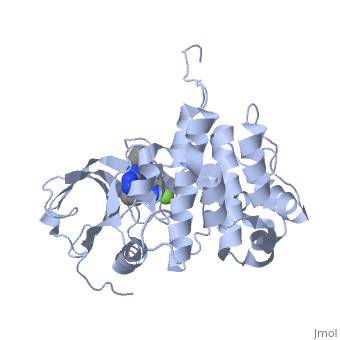Insulin-like growth factor receptor
From Proteopedia
(Difference between revisions)
| Line 1: | Line 1: | ||
<StructureSection load='3i81' size='350' side='right' scene='' caption='Human insulin-like growth factor 1 receptor complex with inhibitor (PDB code [[3i81]])'> | <StructureSection load='3i81' size='350' side='right' scene='' caption='Human insulin-like growth factor 1 receptor complex with inhibitor (PDB code [[3i81]])'> | ||
'''Insulin-like growth factor receptors''' (IGFR) are transmembrane receptors which are stimulated by insulin-like growth factors (IGF). IGFR contains 2 extracellular α chains and 2 transmembranal β chains. Upon binding of IGF, a tyrosine in the β chain becomes autophosphorylated and triggers a cascade of intracellular signaling. The insulin-like growth factor 1 (IGF-1) receptor belongs to the large class of [[Receptor tyrosine kinases|tyrosine kinase receptors]]. See also [[IGF1]], [[Growth factors]] and [[Kinase-linked, enzyme-linked and related receptors]]. | '''Insulin-like growth factor receptors''' (IGFR) are transmembrane receptors which are stimulated by insulin-like growth factors (IGF). IGFR contains 2 extracellular α chains and 2 transmembranal β chains. Upon binding of IGF, a tyrosine in the β chain becomes autophosphorylated and triggers a cascade of intracellular signaling. The insulin-like growth factor 1 (IGF-1) receptor belongs to the large class of [[Receptor tyrosine kinases|tyrosine kinase receptors]]. See also [[IGF1]], [[Growth factors]] and [[Kinase-linked, enzyme-linked and related receptors]]. | ||
| + | |||
| + | *'''Insulin-like growth factor receptor 1''' is. the mediator of the anabolic and mitogenic activity of growth hormone<ref>PMID: 11577173<ref/> | ||
. | . | ||
Revision as of 07:55, 3 July 2024
| |||||||||||
3D structures of insulin-like growth factor receptor
Updated on 03-July-2024
References
- ↑ PMID: 11577173<ref></ref> . === Memory-Enhancement by Traditional Chinese Medicine? <ref>doi 10.1080/07391102.2012.741052</li></ol></ref>

